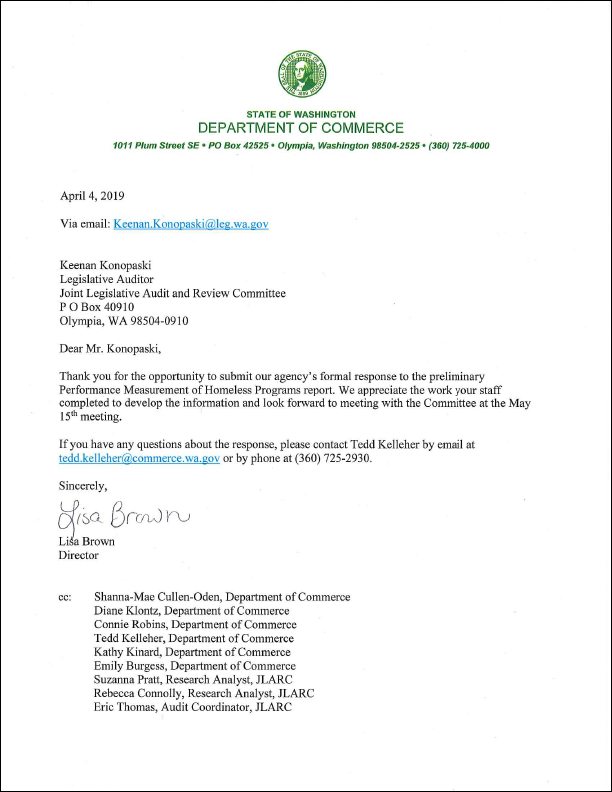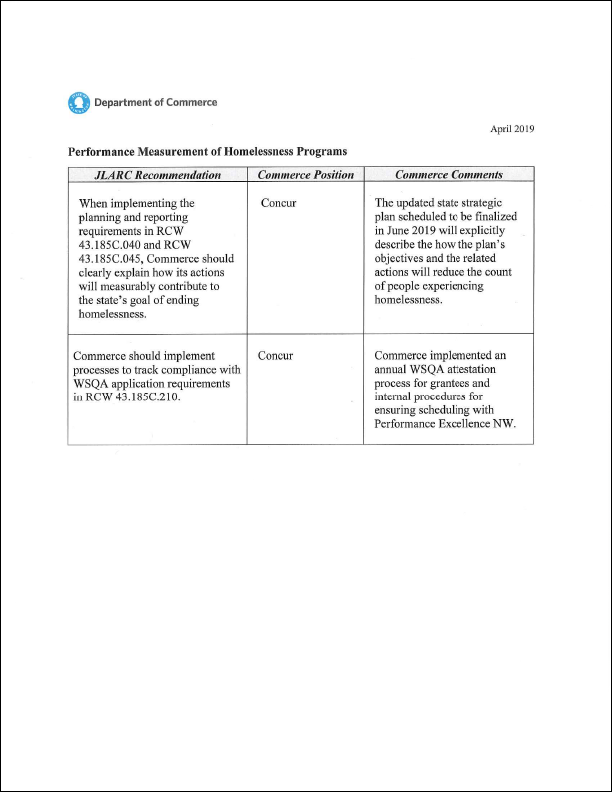JLARC staff reviewed the planning, reporting, performance measurement, and WSQA
requirements throughout Ch. 43.185C.RCW. The following sections are provided as
context for the report, and show language as of December 31, 2017.
Planning, reporting, and performance measurement
RCW 43.185C.040
Homeless housing strategic plan—Program outcomes and performance measures and
goals—Statewide data gathering instrument—Reports.
(1) Six months after the first Washington homeless census, the department shall, in
consultation with the interagency council on homelessness and the affordable housing
advisory board, prepare and publish a ten-year homeless housing strategic plan which
shall outline statewide goals and performance measures and shall be coordinated with
the plan for homeless families with children required under RCW 43.63A.650. To guide
local governments in preparation of their first local homeless housing plans due
December 31, 2005, the department shall issue by October 15, 2005, temporary
guidelines consistent with this chapter and including the best available data on each
community's homeless population. Local governments' ten-year homeless housing plans
shall not be substantially inconsistent with the goals and program recommendations of
the temporary guidelines and, when amended after 2005, the state strategic plan.
(2) Program outcomes and performance measures and goals shall be created by the
department and reflected in the department's homeless housing strategic plan as well
as interim goals against which state and local governments' performance may be
measured, including:
- (a) By the end of year one, completion of the first census as described in RCW
43.185C.030;
- (b) By the end of each subsequent year, goals common to all local programs which
are measurable and the achievement of which would move that community toward housing
its homeless population; and
- (c) By July 1, 2015, reduction of the homeless population statewide and in each
county by fifty percent.
(3)
- (a) The department shall work in consultation with the interagency council on
homelessness, the affordable housing advisory board, and the state advisory council
on homelessness to develop performance measures that address the limitations of the
annual point-in-time count on measuring the effectiveness of the document recording
fee surcharge funds in supporting homeless programs. The department must report its
findings and recommendations regarding the new performance measures to the
appropriate committees of the legislature by December 1, 2017.
- (b) The department must implement at least three performance metrics, in addition
to the point-in-time measurement, that measure the impact of surcharge funding on
reducing homelessness by July 1, 2018.
- (c) The joint legislative audit and review committee must review how the surcharge
fees are expended to address homelessness, including a review of the related program
performance measures and targets. The joint legislative audit and review committee
must report its review findings by December 1, 2022, and update the review every
five years thereafter.
(4) The department shall develop a consistent statewide data gathering instrument to
monitor the performance of cities and counties receiving grants in order to determine
compliance with the terms and conditions set forth in the grant application or
required by the department. The department shall, in consultation with the interagency
council on homelessness and the affordable housing advisory board, report biennially
to the governor and the appropriate committees of the legislature an assessment of the
state's performance in furthering the goals of the state ten-year homeless housing
strategic plan and the performance of each participating local government in creating
and executing a local homeless housing plan which meets the requirements of this
chapter. To increase the effectiveness of the report, the department must develop a
process to ensure consistent presentation, analysis, and explanation in the report,
including year-to-year comparisons, highlights of program successes and challenges,
and information that supports recommended strategy or operational changes. The annual
report may include performance measures such as:
- (a) The reduction in the number of homeless individuals and families from the
initial count of homeless persons;
- (b) The reduction in the number of unaccompanied homeless youth. "Unaccompanied
homeless youth" has the same meaning as in RCW 43.330.702;
- (c) The number of new units available and affordable for homeless families by
housing type;
- (d) The number of homeless individuals identified who are not offered suitable
housing within thirty days of their request or identification as homeless;
- (e) The number of households at risk of losing housing who maintain it due to a
preventive intervention;
- (f) The transition time from homelessness to permanent housing;
- (g) The cost per person housed at each level of the housing continuum;
- (h) The ability to successfully collect data and report performance;
- (i) The extent of collaboration and coordination among public bodies, as well as
community stakeholders, and the level of community support and participation;
- (j) The quality and safety of housing provided; and
- (k) The effectiveness of outreach to homeless persons, and their satisfaction with
the program.
(5) Based on the performance of local homeless housing programs in meeting their
interim goals, on general population changes and on changes in the homeless population
recorded in the annual census, the department may revise the performance measures and
goals of the state homeless housing strategic plan, set goals for years following the
initial ten-year period, and recommend changes in local governments' plans.
RCW 43.185C.050
Local homeless housing plans.
(1) Each local homeless housing task force shall prepare and recommend to its local
government legislative authority a ten-year homeless housing plan for its
jurisdictional area which shall be not inconsistent with the department's statewide
temporary guidelines, for the December 31, 2005, plan, and thereafter the department's
ten-year homeless housing strategic plan and which shall be aimed at eliminating
homelessness, with a minimum goal of reducing homelessness by fifty percent by July 1,
2015. The local government may amend the proposed local plan and shall adopt a plan by
December 31, 2005. Performance in meeting the goals of this local plan shall be
assessed annually in terms of the performance measures published by the department.
Local plans may include specific local performance measures adopted by the local
government legislative authority, and may include recommendations for any state
legislation needed to meet the state or local plan goals.
(2) Eligible activities under the local plans include:
- (a) Rental and furnishing of dwelling units for the use of homeless persons;
- (b) Costs of developing affordable housing for homeless persons, and services for
formerly homeless individuals and families residing in transitional housing or
permanent housing and still at risk of homelessness;
- (c) Operating subsidies for transitional housing or permanent housing serving
formerly homeless families or individuals;
- (d) Services to prevent homelessness, such as emergency eviction prevention
programs including temporary rental subsidies to prevent homelessness;
- (e) Temporary services to assist persons leaving state institutions and other
state programs to prevent them from becoming or remaining homeless;
- (f) Outreach services for homeless individuals and families;
- (g) Development and management of local homeless plans including homeless census
data collection; identification of goals, performance measures, strategies, and
costs and evaluation of progress towards established goals;
- (h) Rental vouchers payable to landlords for persons who are homeless or below
thirty percent of the median income or in immediate danger of becoming homeless; and
- (i) Other activities to reduce and prevent homelessness as identified for funding
in the local plan.
Washington State Quality Award (WSQA) Program Statutes
RCW 43.185C.210
Transitional housing operating and rent program.
(5)(a) Except as provided in (b) of this subsection, beginning in 2011, each eligible
organization receiving over five hundred thousand dollars during the previous
calendar year from the transitional housing operating and rent program and from
sources including:
- (i) State housing-related funding sources; (ii) the affordable housing for all
surcharge in RCW 36.22.178; (iii) the home security fund surcharges in RCW
36.22.179 and 36.22.1791; and (iv) any other surcharge imposed under chapter
36.22 or 43.185C RCW to fund homelessness programs or other housing programs,
shall apply to the Washington state quality award program for an independent
assessment of its quality management, accountability, and performance system,
once every three years.
(5)(b) Cities and counties are exempt from the provisions of (a) of this subsection
until 2018.
43.185C.240
Document recording surcharge funds—Use—Local government obligations— Washington
state quality award program—Department's duties—Definitions. (Section expires June 30,
2019)
(1)(b) Any local government receiving more than three million five hundred thousand
dollars during the previous calendar year from document recording surcharge funds
collected pursuant to RCW 36.22.178, 36.22.179, and 36.22.1791, must apply to the
Washington state quality award program, or similar Baldrige assessment organization,
for an independent assessment of its quality management, accountability, and
performance system. The first assessment may be a lite assessment. After submitting
an application, a local government is required to reapply at least every two years.
(3) This section expires June 30, 2019.
❮ Previous
Next ❯









